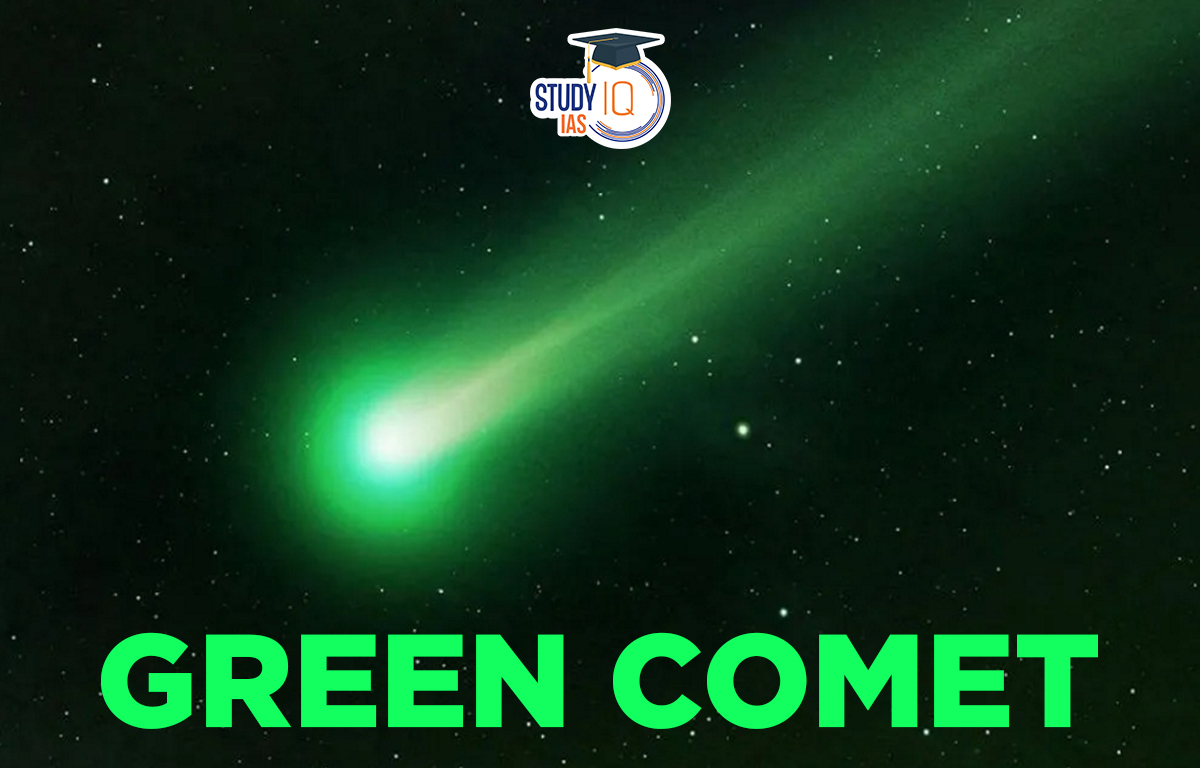Table of Contents
Green Comet
The Green Comet, which was just identified, can be seen in roughly 50 thousand years, and its successor is anticipated in the same time frame. In the middle of January 2023, the Green Comet made a close approach to the sun; it is currently departing from it along its own orbit.
The comet’s orbit suggests that it originates from the Oort cloud, a collection of far-off comets, which is at the boundary of our solar system. The Oort cloud is supposed to be a huge, spherical region of space that surrounds our sun and is made up of many tiny particles, including comets and asteroids. For UPSC Exam Preparation, this article has all the information on Green Comet.
Read More: Climatology
Green Comet Background
The Green Comet was only recently discovered by US astronomers in March 2022. The comet’s head is referred to as the “Green Comet” because it shines green and emits a whitish light behind it (often called the tail of the comet). The comet has already made contact with the Sun and is now moving away from the Sun in its own orbit.
The green glow of the comet’s head is thought to be caused by diatomic carbon, which is two carbon atoms bound together. The molecule emits green light when activated by sunlight’s UV radiation. The green comet might be as close as 27 million miles, according to reports. NASA claims that the comet, which is 2.5 light minutes away from Earth and may be visible with binoculars and telescopes as well as the unaided eye in a bright night sky.
Read More: Precipitation
Green Comet Composition
Comets, which are frozen rocky or gas-filled objects made of dust and ice, circle the Sun. If a comet is mostly made of ice material instead of rocky bits, scientists may sometimes refer to them as dirty snowballs or snowy dirtballs. Like other celestial bodies, comets have orbits.
comets that only last briefly The majority of them were able to leave the solar system. Some are located in the huge disc known as the Kuiper Belt, which stretches past Neptune’s orbit (the eighth and final planet). Less than 200 years pass between them and the Sun. The Oort cloud, the furthest area of the solar system and around 50 times farther from the Sun, is where long-period comets are located. The Oort cloud has a sphere-like structure. Over a period of more than 250,000 years, the comet with the longest known orbit completes one round of the Sun.
Read More: Pressure Belts
How To See Green Comet 2023?
To see a green comet, you can follow these steps:
- Find out the location of the green comet: Currently, there are no known green comets visible to the naked eye, but periodic comets such as Comet 46P/Wirtanen and Comet 21P/Giacobini-Zinner have been known to exhibit a greenish tinge. You can check online for the current location and visibility of comets.
- Choose a good observing location: Select a location that is away from the city lights and provides a clear and unobstructed view of the sky. A dark-sky site or a high-altitude location is preferred.
- Use binoculars or a telescope: A comet’s coma or the fuzzy head around the nucleus can be visible through binoculars or a small telescope. A green filter on the eyepiece can enhance the green color of the comet.
- Plan your observation time: Comets are best observed when they are at their closest to the Earth, and when the Moon is not too bright. The best time to observe a comet is just after sunset or just before sunrise.
- Give your eyes time to adapt: Allow your eyes to adjust to the dark by avoiding bright lights for at least 20-30 minutes before observing the comet.
- Look for a fuzzy, greenish object in the sky: Once you have located the comet, look for a fuzzy object with a greenish tinge. The green color is caused by the gas in the comet’s coma, which is typically dominated by diatomic carbon (C2) and cyanogen (CN).
Green Comet and Green Color
Comets are icy, rocky, or gaseous objects that were part of the solar system’s early development. They typically leave a light in their wake because of their make-up, traits, and motion. The comet in this instance produces a yellowish glow from behind and has a green head (often called the tail of the comet).
Diatomic carbon, which is made up of bonded pairs of carbon atoms, is assumed to be the cause of the comet’s head’s green light. When stimulated by solar UV photons, the molecule emits green light.
Read More: Heat Zones of Earth
Green Comet Feature
The green comet belongs to the category of long-period comets, which take longer than 200 years to orbit the Sun. The comet will return to the Oort cloud and make its next appearance about 50,000 years from now due to its very eccentric orbit.
In a clear night sky, comets may be viewed with binoculars and telescopes, and they may even be visible without them. In the month of January 2023, a comet will be seen in the early sky as it travels quickly to the northwest. Beginning in early February 2023, it will become visible in the Southern Hemisphere. When looking northwest in Indian skies, it can be seen about 16° above the horizon in the Bootes constellation.
Read More: Heat Transfer Methods


 Advanced Air Defence Radars: Types, Comp...
Advanced Air Defence Radars: Types, Comp...
 Ion Chromatography, Working and Applicat...
Ion Chromatography, Working and Applicat...
 Broadly Neutralising Antibodies (bNAbs):...
Broadly Neutralising Antibodies (bNAbs):...

























